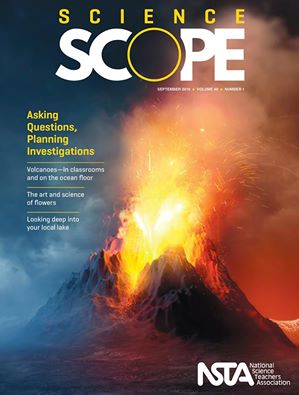What Are the National Academies and How Can You Use Them to Transform Your Teaching?
By Guest Blogger
Posted on 2017-01-17
During Recognition Week for the 2006 Presidential Award for Excellence in Mathematics and Science Teaching, awardees gathered in a Washington, DC, hotel for a federal agencies breakfast. While all 10 agencies present that morning provided awardees with an overview of their educational programs and outreach opportunities, it was The National Academies’ information that especially appealed to my desire to translate educational research into practice. I learned how The National Academies advances and fosters an awareness of the best cutting-edge science and its use in programs and reports. Unlike other Academies in many other countries, the U.S. Academies are not an arm of the federal government. The National Academies are a private, non-profit organization that depends on grants and contracts to support their work.
Later during Recognition Week, I received a copy of Taking Science to School, a consensus report from The National Academies during one of the professional development sessions. Besides the National Science Education Standards, this book was my first in depth exposure to a National Academies evidence-based consensus report. Upon receiving the report, a summary of major findings and conclusions was provided by one of the reports committee members. It was during this professional development session that I became aware of the four strands of science learning. (See October 2016 Science Scope for related article).
As I began thumbing through the table of contents and previewing chapters, I was drawn to the quote from Henri Poincare at the beginning of chapter 2, which states: “Science is built up of facts as a house is of stones, but a collection of facts is no more a science than a pile of stones is a house.” I was captivated by a subtitle on the same page, What is Science? and thought, since I was invited to Washington because of science teaching, I should read this section! I was perplexed however, when reading this section because my beliefs were challenged about the scientific method, an approach I had embraced in my teaching for years. I even had a poster in my classroom which described the method steps for direct experimentation. Upon additional reading, I learned this method treats science as a series of disembodied skills and fails to develop meaningful understanding. That feeling of cognitive dissonance and deeper reflection on practice has often led to an alteration of classroom behavior.
This new perspective in my thinking about some of the most tightly held and accepted premises of STEM and education that resulted from this report are typical of the findings, conclusions, and recommendations that emerge from National Academies’ consensus reports and publications from public workshops, symposia, and convocations. Founded in 1863 by an Act of Congress, The National Academies has served as an advisor to the nation on all matters of science, engineering, technology, and medicine. The original organization consisted of The National Academy of Sciences, but has since grown to now include The National Academies of Engineering and Medicine. The Academies are both honorific, where members elect other members who are recognized for lifetime achievement in these fields (most of the American Nobel Laureates named each year are members of one or more of the Academies), and they oversee the work of advising the nation. Additional details about how the Academies carry out their mission and work can be found here.
As a result of a clause in the original charter, all of the people who serve on The National Academies committees, prepare reports, and oversee the organization of workshops and symposia are volunteers, committing anywhere from six months to two years (depending on the project) in service to the American people. Each year approximately 6000 volunteers serve on some 500 to 600 ad hoc and permanent committees. The Academies publish about 250 reports each year, all available for free downloading at the website National Academies Press (http:/nap.edu). Visitors to this website also can sign up to receive notices about newly released reports in any area(s) of interest. A number of publications have been prepared for teacher practitioners. For example, the publication Taking Science to School also led to a practitioner volume for elementary and middle school teachers, Ready, Set, Science!: Putting Research to Work in K-8 Science Classrooms (available for free download here).
Since that breakfast a decade ago, I have relied on consensus reports from The National Academies to inform and guide my teaching. Turning to the National Academies for trusted advice based upon evidence, is now a natural part of my teaching practice. Other education-focused reports of The National Academies you may find meaningful in your work are:
- A Framework for K-12 Science Education: Practices, Crosscutting Concepts, and Core Ideas
- Developing Assessments for the Next Generation Science Standards
- STEM Integration in K-12 Education: Status, Prospects, and an Agenda for Research
- Monitoring Progress Toward Successful K-12 STEM Education: A Nation Advancing?
Author Kenneth L. Huff (khuff@ williamsvillek12.org) is the NSTA Division Director, Middle Level Science Teaching; a science educator at Mill Middle School in Williamsville, New York; and Vice Chair of The National Academies’ Teacher Advisory Council (http://nas.edu/tac).
Join NSTA today and receive Science Scope, the peer-reviewed journal just for middle school teachers; connect on the middle level science teaching list (members can sign up on the list server); or consider joining your peers for Meet Me in the Middle Day (MMITM) at the National Conference on Science Education in Los Angeles in the spring of 2017.
The mission of NSTA is to promote excellence and innovation in science teaching and learning for all.
Future NSTA Conferences
-
2017 National Conference
2017 STEM Forum & Expo
2017 Area Conferences
Follow NSTA
Disclaimer: The views expressed in this blog post are those of the author(s) and do not necessarily reflect the official position of the National Science Teaching Association (NSTA).


